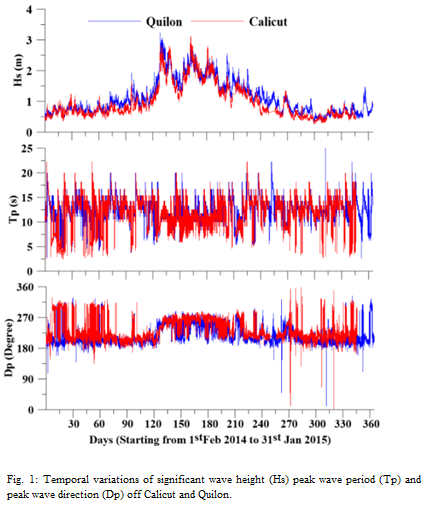 The Southwestern Shelf Sea (SWSS) of India has a distinct wave pattern, which makes it different as compared to the adjoining regions. Wave directional spectra during the monsoon season are comparatively broader and double peaked in contrast to that of the western shelf sea. The well-defined directional bi-modality is observed during the south west monsoon which is attributed to the coexistence of the south Indian Ocean swells and the southwest monsoon swells. The shamal swells generated by the shamal wind blowing from the Arabian Peninsula are found to have a significant influence on the wave pattern of the SWSS. In addition, the local sea breeze/land breeze also contributes significantly to the observed changes, particularly to the diurnal variation. A distinct phase lag in occurrence of the maximum significant wave height for the wind sea component is also observed in the northern region of the SWSS during the fair seasons.
The Southwestern Shelf Sea (SWSS) of India has a distinct wave pattern, which makes it different as compared to the adjoining regions. Wave directional spectra during the monsoon season are comparatively broader and double peaked in contrast to that of the western shelf sea. The well-defined directional bi-modality is observed during the south west monsoon which is attributed to the coexistence of the south Indian Ocean swells and the southwest monsoon swells. The shamal swells generated by the shamal wind blowing from the Arabian Peninsula are found to have a significant influence on the wave pattern of the SWSS. In addition, the local sea breeze/land breeze also contributes significantly to the observed changes, particularly to the diurnal variation. A distinct phase lag in occurrence of the maximum significant wave height for the wind sea component is also observed in the northern region of the SWSS during the fair seasons.
Bibliographic Info: Anoop, T. R., Sheela Nair, L., Prasad, R., Reji Srinivas, Ramachandran, K. K., Prakash, T. N., Balakrishnan Nair, T.M. [2020]. Locally and remotely generated wind waves in the southwestern shelf sea of India. Journal of Coastal Research, Special Issue 89, pp. 77-83. https://doi.org/10.2112/SI89-014.1




 RTI Act
RTI Act
